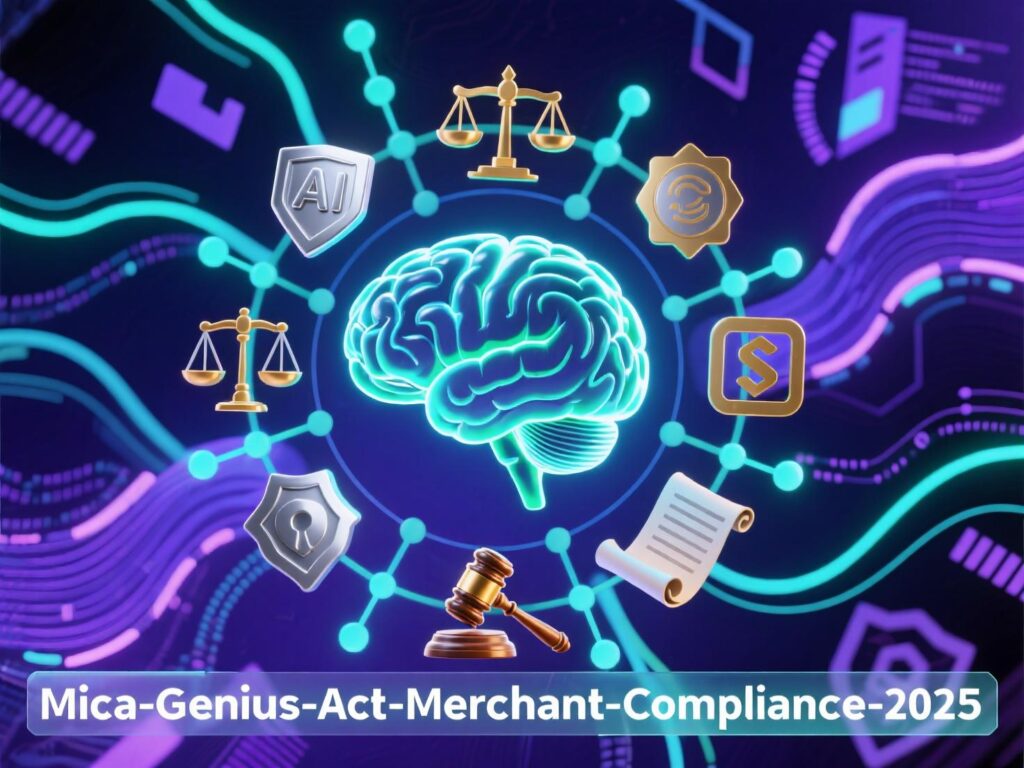Crypto Payments in E-Commerce 2025
In 2025, crypto payments in e-commerce have moved from “experimental” to strategic. Stablecoin rails (USDC, PYUSD), enterprise-grade gateways, and clearer rules in the US and EU are making digital assets viable for checkout and settlements. Merchants care because fees impact margins, chargebacks erode profit, and cross-border conversion costs limit international growth. Crypto can help on all three fronts especially when you route through stablecoins and mainstream gateways.
Card processing commonly starts at ~2.9% + $0.30 per online transaction in major markets, which is material at scale. By contrast, crypto gateways often charge ~1% (or 1–2% capped) and eliminate chargebacks, while settlement can be faster and global by design. At the same time, compliance requirements from Europe’s MiCA to US tax reporting mean you must implement crypto payments with a controls-first mindset.
This guide distills what changed in 2025, how fees really compare, what your legal backstops are, where crypto payments in e-commerce shine (and where they don’t), and a practical 7-step integration plan you can ship this quarter. Along the way, you’ll see real-life examples and a quick ROI model so finance and product teams can green-light with confidence. ifyCoinbase HelpBitPay+1
What’s New & Why It Matters
Stablecoins go mainstream for commerce. Stripe launched stablecoin accounts and Shopify-facing stablecoin acceptance; merchants can receive local-currency settlements or USDC directly. This makes on-chain payments feel like standard payouts.
Adoption outlook. Insider Intelligence projects US crypto payment users to jump ~82% from 2024–2026 (still niche overall), signaling real but measured growth for checkout.
Payment mix shifts. Worldpay’s 2025 report highlights digital wallets’ dominance in e-commerce; crypto lives within that “alternative” stack and benefits from the wallet UX trend.
Stablecoins scale. Stripe notes ~$238B stablecoins in circulation with rising daily transactions evidence that the rails are liquid enough for mainstream use cases.
Fees & Chargebacks: The Margin Math
Card rails (baseline for comparison)
Typical online card fees start around 2.9% + $0.30; international/cross-currency adds more.
Crypto gateway rails
Coinbase Commerce: 1% per crypto payment.
BitPay: tiered 1–2% + $0.25 depending on monthly volume (lower at enterprise scale).
Chargebacks
Blockchain “push” payments aren’t reversible like card “pull” payments, removing classic fraud chargebacks (refunds are policy-driven, not card-scheme enforced). This is a major ops and cost win for risk teams.
What it means: For a $100 AOV, moving just 10% of orders to crypto at a 1% fee (vs. 2.9% + $0.30) can reclaim meaningful margin especially at scale and cross-border.

Regulations & Compliance Merchants Must Know (2025)
United States (Stablecoins): The GENIUS Act of 2025 establishes a federal framework for payment stablecoins; issuers face BSA/AML obligations and OCC/primary-regulator oversight, while Treasury is now collecting implementation feedback. Merchants benefit from improved clarity on permitted stablecoins and partner due diligence.
EU (MiCA/MiCAR): The EU’s MiCA regime entered into effect in late 2024 with transitional windows in 2025; CASP authorization and stablecoin controls are the new norm. Merchants relying on EU-based PSPs/gateways should confirm MiCA alignment (especially for e-money tokens).
Tax (US): The IRS treats crypto as property; crypto received for goods/services is taxable income at fair market value. IRS communications throughout 2025 continue to emphasize accurate reporting; broker reporting rules and 1099-DA changes heighten transparency. Coordinate with your tax team.
Where Crypto Payments Shine in E-Commerce
Global expansion: Settle internationally without card cross-border penalties; stablecoins reduce FX surprises. PYUSD also rides PayPal’s network footprint, broadening UX familiarity.
Lower fees & fewer fraud losses: As above, you can trim take-rate and remove chargeback overhead.
Faster settlements & treasury optionality: Near-instant on-chain settlement with the choice to hold stablecoins or auto-convert to fiat. Stripe/Shopify workflows make this more “button-click” than “DIY.”
Caveats: On-chain network fees can spike at peaks (most gateways abstract this), and refund UX must be policy-driven since transactions are irreversible.

Real-Life Examples (Brief Case Notes)
Camping World (Retail, high AOV): Began accepting crypto via BitPay to “maximize convenience and attract new consumers” without holding crypto on the balance sheet a template for discretionary, high-ticket e-commerce.
Shopify ecosystem (SMB to enterprise): Stripe’s 2025 announcements bring stablecoin acceptance and local-currency settlements to millions of Shopify merchants, mainstreaming crypto checkout alongside cards and wallets.
Implementation Playbook: How to Add Crypto Payments in E-Commerce
Define scope
(coins & flows): Start with stablecoins (USDC, PYUSD) for low volatility; add BTC/ETH for audience breadth. Map use cases: checkout, refunds (policy-driven), payouts.
Select a gateway & settlement model:
Compare Coinbase Commerce (1% fee, broad wallet support) and BitPay (tiered 1–2% + $0.25). Decide fiat vs. crypto settlement and accounting treatment.
Integrate with your platform:
Shopify:
enable third-party crypto apps; Stripe’s stablecoin acceptance lands funds like any other payout.
WooCommerce:
official Coinbase Commerce plugin/docs support quick install and API key setup.
Set risk & refund policies:
Publish clear refund flows (e.g., refund in original crypto or stablecoin equivalent); communicate no chargebacks policy to reduce disputes.
KYC & compliance checks:
Vendor due diligence for MiCA/GENIUS alignment and AML controls; capture tax data for crypto receipts.
Treasury operations:
Decide on auto-conversion to fiat vs. holding stablecoins; articulate custody, access control, and reconciliation procedures. Stripe/PSPs provide “bank-account-like” flows for stablecoins.
Measure ROI:
Track payment mix, authorization rate, fees saved, and fraud/chargeback delta. Iterate incentives (e.g., small discounts for crypto to shift share).
Pro tip:
Put crypto payments in e-commerce behind a progressive rollout (geo, device, returning customers) and A/B test placement in your wallet row to protect conversion while learning.
2025 Tech & Product Checklist
Wallet UX: prominent but not primary; clear “What is this?” tooltip.
Price locking: show guaranteed price window (e.g., 15 minutes) for on-chain confirmations.
Refund tooling: automate wallet address capture + AML checks.
Reconciliation: export payout files; map tax lots for accounting.
Fraud posture: keep behavioral/risk controls for account takeover; crypto removes card fraud but not account fraud.
Accessibility: ensure crypto option is mobile-friendly and localized.

Bottom Lines
In 2025, crypto payments in e-commerce are a practical lever to reduce fees, unlock new geographies, and lower chargeback risk especially via stablecoins and mainstream gateways. The regulatory runway is clearer in key markets, and platforms like Shopify and Stripe are abstracting complexity away. Success now looks operational, not experimental: start with stablecoins, settle in fiat, publish refund policies, and measure ROI. Most merchants can pilot within weeks, then scale based on savings, conversion, and customer feedback.
Call to action: Want a launch-ready plan tailored to your stack (Shopify, WooCommerce, custom) and regions? Grab the implementation checklist above, then run a 90-day pilot with 10–20% checkout exposure. We can provide a fee-savings model, risk policy templates, and schema-optimized content to drive visibility. Let’s make your payment mix work harder today.
FAQs
1) How do I add crypto payments in e-commerce without hurting conversion?
A: Start with stablecoins (e.g., USDC, PYUSD), keep crypto as a secondary wallet option, and settle to fiat automatically. Roll out to a small audience segment, A/B test placement in the payment row, and monitor take-rate, authorization rate, fee savings, and NPS before expanding.
Quick tip: Add a short “What is this?” tooltip to educate shoppers.
2) How are crypto fees different from cards?
A: Online card processing often bundles percentage + fixed fees and cross-border surcharges. Crypto gateways usually charge a simpler take rate and remove card-scheme chargebacks. Your savings depend on AOV, cross-border mix, and gateway pricing.
Quick tip: Model $/order with your actual AOV and traffic split.
3) How do refunds work if blockchain transactions are irreversible?
A: Refunds are merchant-initiated, not chargeback-driven. Document whether you refund in the original asset or a stablecoin equivalent and how you handle rate changes. Automate wallet address capture and verification to avoid misdirected refunds.
Quick tip: Show a clear refund SLA and FX policy at checkout.
4) How does regulation affect my store in 2025?
A: Work with regulated gateways that comply in your selling regions (e.g., MiCA in the EU; evolving stablecoin frameworks in the US). Maintain standard AML/KYC vendor diligence and retain transaction records for audits.
Quick tip: Keep a one-pager listing approved coins, provider registrations, and contacts.
5) What coins should I accept first?
A: Lead with widely used stablecoins (USDC, PYUSD) to minimize volatility and simplify accounting. Offer BTC/ETH for customer reach if your audience skews crypto-native, but auto-convert to fiat unless treasury policy allows holding.
Quick tip: Start with one stablecoin, add more as support tickets stay low.
6) How fast are settlements and confirmations?
A: Blockchain confirmations are typically minutes; gateway payouts follow your normal cadence (daily/rolling). Display a price-lock timer (e.g., 10–15 minutes) so customers know how long they have to pay before rates refresh.
Quick tip: Send payment status webhooks to your OMS to prevent double-ships.
7) How do chargebacks and fraud change with crypto?
A: There are no card chargebacks for on-chain “push” payments, but account-level fraud (ATO, reshipping, triangulation) still exists. Keep identity/risk signals, velocity checks, and allowlist/denylist logic.
Quick tip: Route high-risk orders to manual review regardless of tender type.
8) Do customers really want to pay with crypto in 2025?
A: Adoption is growing but remains a minority share. It’s strongest among global shoppers, privacy-minded users, and high-AOV categories. Treat it as an incremental option that can reduce fees and expand reach rather than a primary tender—at least initially.
Quick tip: Incentivize with a small discount to test demand elasticity.
9) What accounting and tax records do I need?
A: Record the fiat value at receipt time, the asset used, tx hash, wallet address, and any conversions. Reconcile payouts like other tenders and retain logs for audits and tax filings.
Quick tip: Export monthly CSVs from your gateway and align them to SKU-level sales.


